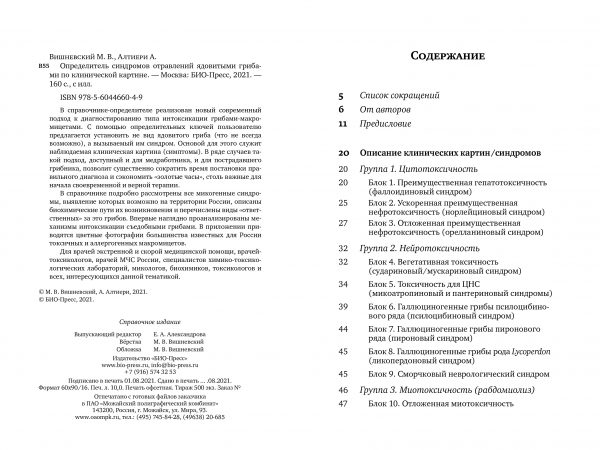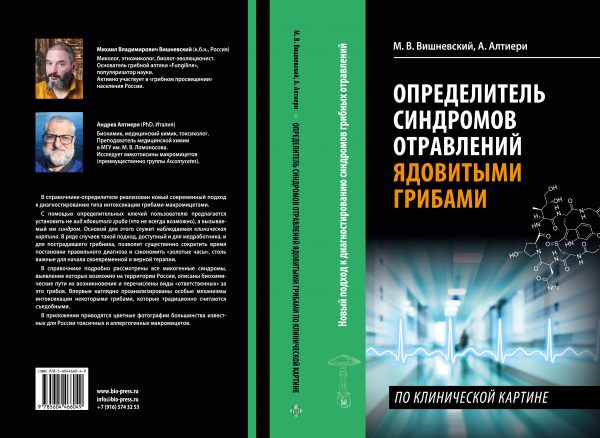M. Vishnevsky, A. Altieri. The determinant of poisoning syndromes by poisonous mushrooms according to the clinical picture.
3600 ₸
The reference guide implements a new modern approach to diagnosing the type of intoxication by fungi-macromycetes. With the help of identifying keys, the user is asked to establish not the type of poisonous mushroom (which is not always possible), but the syndrome caused by it. The basis for this is the observed clinical picture (symptoms). In some cases, such an approach, accessible to both the medical worker and the injured mushroom picker, will significantly reduce the time for making the correct diagnosis and save the “golden hours” so important for starting timely and correct therapy.
The handbook describes in detail all mycogenic syndromes that can be detected on the territory of Russia, describes the biochemical ways of their occurrence and lists the types of fungi “responsible” for this. For the first time, the special mechanisms of intoxication by some mushrooms, which are traditionally considered edible, are clearly analyzed. The appendix contains color photographs of most of the toxic and allergogenic macromycetes known for Russia.
For emergency and emergency medical doctors, toxicologists, doctors of the Ministry of Emergency Situations of Russia, specialists of chemical and toxicological laboratories, mycologists, biochemists, toxicologists and anyone interested in this topic.
Additionally
| Dimensions | 140 × 210 cm |
|---|
Content
5 List of abbreviations
6 From the authors
11 Preface
20 Description of clinical pictures/syndromes
20 Group 1. Cytotoxicity
20 Block 1. Predominant hepatotoxicity (phalloidin syndrome)
25 Block 2. Accelerated predominant nephrotoxicity (norleucine syndrome)
27 Block 3. Delayed predominant nephrotoxicity (orellanin syndrome)
32 Group 2. Neurotoxicity
32 Block 4. Vegetative toxicity (sudarin/muscarin syndrome)
34 Block 5. Toxicity to the central nervous system (mycoatropin and pantherin syndromes)
39 Block 6. Hallucinogenic mushrooms of the psilocybin series (psilocybin syndrome)
44 Block 7. Hallucinogenic mushrooms of the pyron series (pyron syndrome)
45 Block 8. Hallucinogenic fungi of the genus Lycoperdon (lycoperdon syndrome)
45 Block 9. Morel neurological syndrome
46 Group 3. Myotoxicity (rhabdomyolysis)
47 Block 10. Delayed myotoxicity
48 Group 4. Metabolic, endocrine and related toxicoses
51 Block 11. Blocking of GABA synthesis (gyromitrin syndrome)
53 Block 12. Disulfiram-like intoxication (coprine syndrome)
56 Block 13. Polypore acid intoxication (polypore syndrome)
57 Block 14. Hyperprocalcitonemia
58 Group 5. Intoxication with LCD effects (resinoid syndrome)
59 Block 15. Intoxication with LCD effects (resinoid syndrome)
70 Group 6. Special adverse reactions to mushrooms
71 Block 16. Paxillus syndrome
73 Block 17. Lycoperdonosis
74 Block 18. Shiitake dermatitis
74 Block 19. Encephalopathy syndrome
77 Defining keys
APPLICATIONS
86 List of the types of toxic and allergogenic fungi established for Russia by clinical pictures/syndromes
92 Cited literature
97 Atlas of the main types of toxic and allergogenic fungi in Russia









Reviews
There are no reviews yet.